It’s time to take the “Kiss the Cook” apron out of hibernation, check your propane or charcoal supplies, and get ready for a season of barbecuing. The sizzle of food on the grates, the hearty flavors of grilled food, and the joy of cooking outdoors all come together for a truly enjoyable experience.
Whether you’re hosting a party or just making a meal for your family, Connecticut farmers and producers can supply you for your next cookout — and many more to come. Here’s how CT Grown can make for a tastier grilling experience.
CT Grown grilling meats
Connecticut farmers may specialize in a single type of livestock, or they may raise several types of animals. Check out the farms around you and you’ll find beef, chicken, pork, turkey, and lamb, all raised with the goal of producing high-quality meats.
You may be surprised to discover that Connecticut has some unconventional livestock producers as well. A handful of farms in the state raise bison and emu, which are touted as having lower fat than traditional meats.
Most livestock producers in Connecticut sell directly to the consumer, and they often have special promotions or services to cater to these customers. You may discover discounts on bulk purchases at the start of the summer, giving you an affordable way to stock up on a larger quantity of meat for the season, or giveaways and bonus products available with certain purchases. CT Grown farms may also offer delivery services to bring meat directly to your doorstep, or convenient pickup options at their farm store or a nearby farmers’ market.
Meat has become a popular option in Community Supported Agriculture (CSA) programs, with many livestock producers either partnering with other farms or running their own program. CSAs allow you to purchase a share of the farm’s product in advance, then regularly pick up a selection of meats over the course of several weeks.
If you’re looking for more variety in your meals, check out the meat sampler boxes that many Connecticut farms have started to offer. These boxes contain different cuts such as roasts, steaks, burgers, and short ribs, allowing you to experiment with different recipes.
Ordering CT Grown meat in bulk
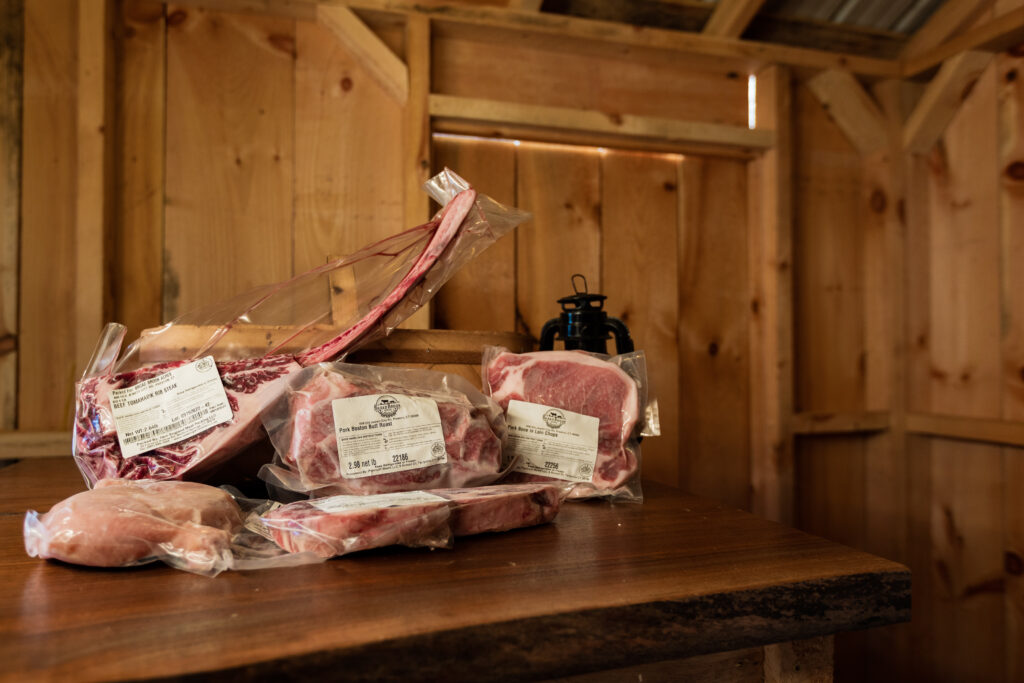
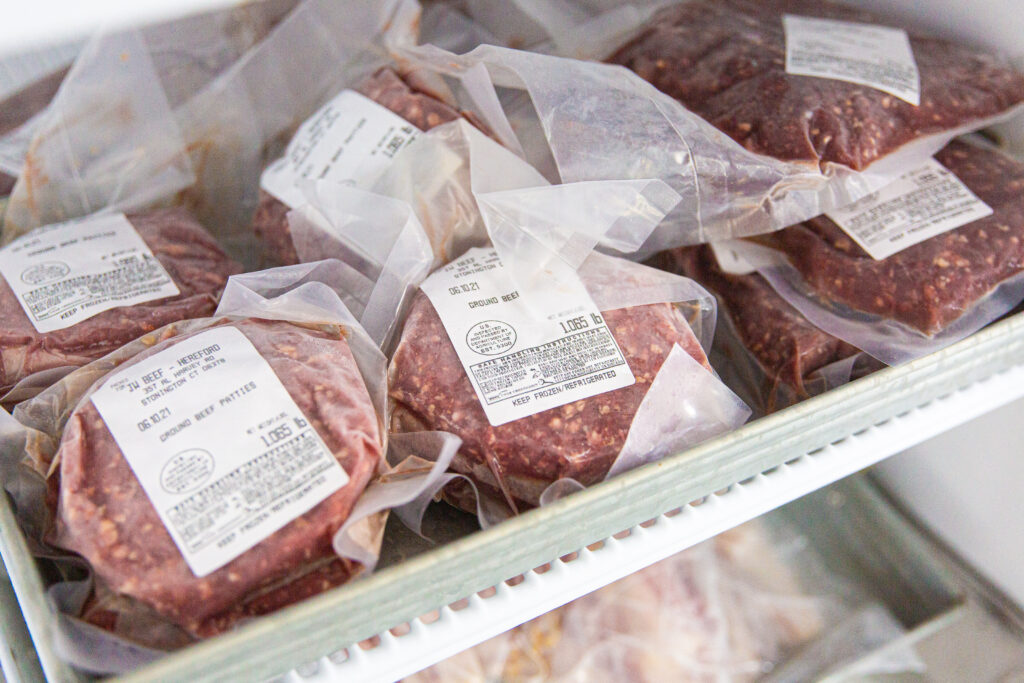
For grilling enthusiasts interested in purchasing more local meat, Patty Taylor of Devon Point Farm in North Stonington says the first thing you should do is get a good freezer.
“When people invest in a freezer, they enable themselves to buy in bulk from local farmers,” she says. “They save money from all the driving to stores and paying increasing grocery store prices, and they get the convenience of walking to their basement or garage to make a dinner barbecuing selection.”
Unlike shopping at a grocery store, a visit to a local livestock farm allows you to order portions such as a whole, half, or quarter cow. Some portions will yield hundreds of pounds of meat — enough to keep you supplied through the grilling season and beyond. You can also take advantage of services like custom butchering to select your preferred cuts.
To store such a large quantity of meat, Taylor recommends using heavy-duty milk crates or laundry baskets in a chest freezer so that cuts of meat can be easily organized and lifted out. She says upright freezers should have an organizational system that makes the best use of available space, such as boxes that fit on the shelves and have shallow cuts to access their contents
Whole and half pigs are also available, with whole pigs typically providing more than 100 pounds of pork. Some farms give you the option of renting cookers to prepare this meat, giving you the opportunity to hold a pig roast when hosting a large party.
These roasts are popular from May into fall, so be sure to reserve the equipment several weeks before your occasion. You should also provide this advance notice when making a bulk order of meat.
Where can I find CT Grown meats?
Check out the CT Grown map to find a livestock producer near you. There are also many locally owned meat markets and butcher shops that partner with CT Grown farms.
CT Grown seafood on the barbecue
You don’t just have to limit your barbecue to land-based items. Connecticut has a thriving aquaculture business, with local fishing boats hauling in catches of fish, oysters, clams, lobster, squid, scallops, mussels, crab, and more from Long Island Sound and the Atlantic Ocean.
Thicker, stronger cuts of fish can be grilled directly on the grates. More delicate filets should be wrapped in tinfoil before grilling, or prepared on a cedar plank to add a smoky flavor.
Shellfish can also be cooked on the grill, and this method is particularly useful when preparing oysters. Instead of the lengthy and sometimes complicated process of shucking with a knife, grilling causes oysters to simply pop open once they’re heated enough.
Fish markets throughout Connecticut can keep you supplied with fresh, locally caught seafood. Stonington Fresh, a program of the state’s only commercial fleet, maintains a listing of retailers, wholesalers, and other partners who carry the latest catch.
Grilled vegetables and fruits
Reserve some space on the grill for CT Grown vegetables. Cooking veggies on the grill will soften them up, give them a smoky flavor and crispy edge, and help them retain more nutritional value compared to cooking methods like steaming or frying.
To start the grilling season, you can wrap broccoli or asparagus in tinfoil with a light seasoning of salt, pepper, oil, and garlic. Summer squash such as zucchini can be cooked directly on the grill.
Throughout the harvest season, you’ll be able to pick up fresh CT Grown vegetables that also taste great when grilled. Some examples include corn, peppers, onions, winter squash, mushrooms, brussels sprouts, cabbage, eggplant, and potatoes.
Many local fruits also grill well, with the heat caramelizing their sugars and enhancing their sweetness. Try it at your next barbecue with seasonal options like apples, nectarines, peaches, pears, plums, or watermelon.
Fruits and vegetables can easily be paired with local meats on kebabs. You can also serve them as is, or chop them up to mix into other dishes such as pasta salads.
CT Grown barbecue sauce

Visit a farm store, farmers’ market, or local retailer and you’ll discover barbecue sauces made right here in Connecticut. This type of value-added food is popular among CT Grown farmers, since it allows them to make use of bountiful harvests or unsold vegetables that would otherwise go to waste.
Barbecue sauces are made using local ingredients such as peppers, maple syrup, garlic, onion, and tomatoes. It’s a great way to support your local farm while also adding a little zing to your dish.
Connecticut BBQ events in 2023
If grilling at home isn’t enough, check out one of these upcoming barbecue-themed events in Connecticut:
- Essex Annual Shad Bake (June 3): It isn’t a barbecue in the traditional sense, but it’s certainly a one-of-a-kind Connecticut cookout! Typically held on the first weekend of June, this celebration in Essex prepares shad — Connecticut’s state fish — by nailing them to wooden planks around a smoky fire pit.
- Sun BBQ Fest (June 17-18): This event at Mohegan Sun features local and nationally renowned BBQ chefs, giving you a chance to sample mouthwatering wings, ribs, fried chicken, and more. You can also enjoy live music as well as cornhole and ax throwing competitions.
- Connecticut BBQ Challenge (July 1): An official competition of New England BBQ, this event will be held at Sonny’s Place in Somers and challenge chefs to prepare the best chicken, pork, or ribs.
The spring season brings a welcome return of color to the Connecticut landscape, with warming temperatures signaling the start of a new growing season. We’re taking off our winter coats, starting preparations for our home gardens, and marking our calendars to get a bouquet for Mother’s Day.
It all makes for a busy time for CT Grown greenhouses, nurseries, and flower and sod producers. Across Connecticut this spring, you’ll find cut flowers, potted plants, bedding plants, hanging baskets, and more to make your home and garden beautiful this year.
This guide will share some of the amazing flowers grown locally, and give you tips on where to find them.

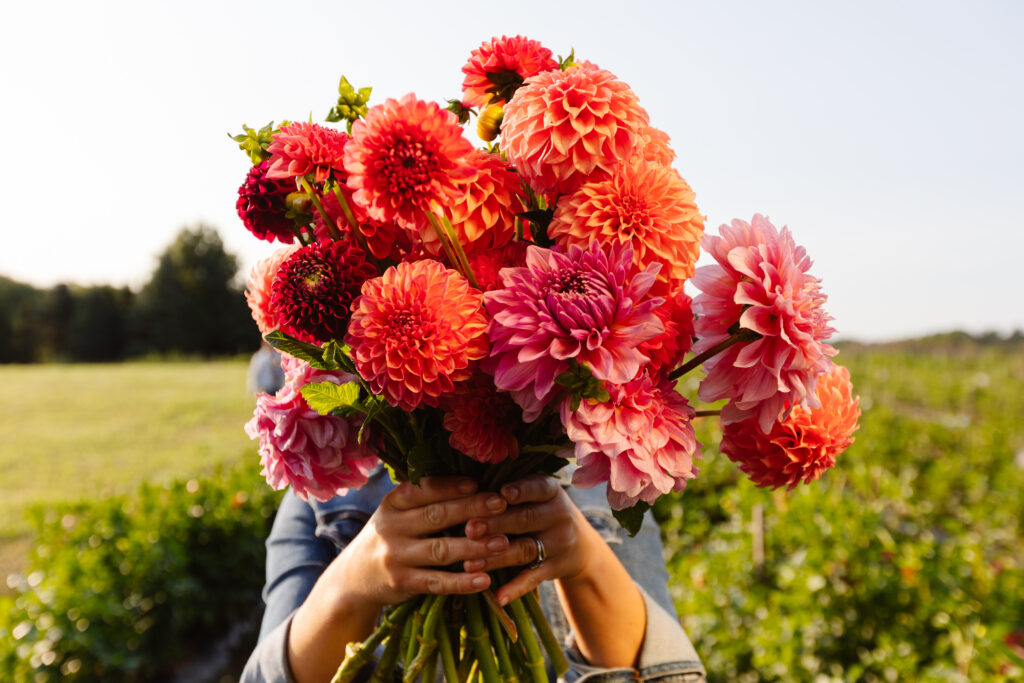
Perennial flowers
Perennials are a favorite among gardeners because they return year after year and don’t need to be replanted. An underground structure, such as a bulb, allows them to stay dormant over the winter and regrow in the spring.
Popular options for spring-flowering perennials in Connecticut include:
- Alliums
- Asters
- Coneflowers
- Cranesbill geraniums
- Daffodils
- Foxglove
- Hyacinth
- Irises
- Lavender
- Peonies
- Phlox
- Tulips
Once the risk of a final spring frost has passed, you can also plant bulbs for perennial flowers that will bloom in the summer. Some options include begonias, dahlias, and lilies.
Annual flowers
Annual flowers grow for a single season and need to be replanted each year. They work well alongside perennials, which usually have a shorter flowering period, and allow gardeners to experiment with new and interesting flowers each year. Some flowers are technically perennials, but are grown as annuals due to their shorter lifespan.
Some popular options for annuals that can be planted in the spring include:
- Calendulas
- Larkspur
- Marigolds
- Petunias
- Snapdragons
- Sunflowers
- Sweet alyssum
- Zinnias
Flowering shrubs
Flowering shrubs are large, woody perennial plants that are well-suited for landscaping purposes. They can be used not only to make your home more attractive, but also as a natural way to define property lines and create a privacy screen.
Some popular options for flowering shrubs in Connecticut include:
- Azaleas
- Forsythia
- Hydrangeas
- Lilacs
- Mountain laurel
- Rhododendrons
Flower farms
Some farms in Connecticut specialize in growing cut flowers, and spring allows them to start hosting pick-your-own occasions and other events.
One example is the “Dancing Daffodils” field at Halfinger Farms in Higganum, where visitors can collect the bright yellow flowers for 70 cents apiece. At Wicked Tulips in Preston, a ticketed pick-your-own event lets you stroll through the fields and collect 10 tulips; the farm also hosts Yoga in the Tulips events during the spring.
Farms may also grow flowers alongside their other crops, and these blooms have become an increasingly popular option for CSAs. These programs let you regularly pick up bouquets of freshly cut flowers, bringing a bright and aromatic addition to your home for several weeks. Traditional CSAs may also offer an add-on option for flowers.
Plant and seedling sales in Connecticut
While early spring is typically too cold to begin growing plants outdoors in Connecticut, you can get a head start by planting seeds indoors and transplanting them once it gets warmer. You can also find seedling and plant sales across the state that have already started this process for you.
Plant and seedling sales offer annual and perennial flowers as well as seedlings for herbs and vegetables. Some give a special focus to native plants — species that occur naturally in the region and thus are beneficial to the local ecosystem.
Sales are sometimes hosted by farms to help generate revenue early in the season. They are also a popular fundraiser for organizations like garden clubs and arboretums.
Some upcoming plant and seedling sales in Connecticut include:
- Connecticut River Coastal Conservation District 2023 Native Plant and Plug Sale, Chester, April 28-29, 2023
- Connecticut Horticultural Society Plant Sale & Auction, Berlin, May 5, 2023
- Hill and Dale Garden Club Plant Sale, Glastonbury, May 6, 2023
- Friends of Hammonasset Plant Sale, Madison, begins May 11, 2023
- Bartlett Arboretum & Gardens Plant Sale, Stamford, May 13, 2023
- West Hartford Garden Club Spring Plant Sale, West Hartford, May 20, 2023
Connecticut flower festivals
The Connecticut Flower and Garden Show, which occurs annually in late February, attracts upwards of 40,000 people. Flower festivals, hosted by garden clubs and other organizations, continue into the spring. These are some of the upcoming events that herald the return of spring:
- Cherry Blossom Festival, New Haven, April 16, 2023
- Daffodil Day, Middletown, April 23, 2023
- Daffodil Days, Essex, through April 23, 2023
- Fine Art and Flowers, Hartford, April 28-30, 2023
- Meriden Daffodil Festival, Meriden, April 29-30, 2023
- May Market, Farmington, May 5, 2023
- Colorblends House and Spring Garden: Bridgeport, through May 7, 2023
- Dogwood Festival, Fairfield, May 13-14, 2023
Nurseries and greenhouses

Greenhouses, nurseries, and flower and sod producers represent the largest farm sector in Connecticut, accounting for more than half of the state’s agricultural production as measured by gross sales. They also have a considerable add-on impact to the state’s economy, supporting additional businesses such as florists and landscaping services.
While the terms are often used interchangeably, greenhouses and nurseries serve separate purposes. Greenhouses shield plants from the elements under glass or other protection, allowing for year-round cultivation. Nurseries don’t necessarily use this protection, and primarily serve to grow plants to a mature size. However, greenhouses can still be considered nurseries if they are used for this purpose.
Connecticut has almost 600 greenhouse growers, primarily specializing in cut flowers, flowering plants, and garden plants. Greenhouses shelter nearly 13 million square feet of cultivation space, and Connecticut ranks 15th in the nation for total greenhouse area.
Greenhouse operations are often paired with outdoor acreage to grow more flowers and plants during the warmer seasons. Connecticut has a mix of both small businesses and larger wholesale nurseries, which distribute plants throughout the world.
Gardeners may have the option to visit a nursery or greenhouse directly to browse the available selection. However, some businesses only deliver their products to landscapers, wholesalers, or garden centers.
Garden centers
Garden centers receive a selection of flowers and other plants from producers. They are also set up as one-stop shops for all your gardening needs. Some garden centers operate independently, while others are an on-site feature of greenhouses and nurseries.

In addition to flowers and plants, garden centers provide items like soil mixes, gardening tools, seeds, fertilizers, and garden decor. They can also offer services like landscape design and installation, as well as clubs and events to provide gardening advice.
As an added bonus, Connecticut garden centers may partner with local farms to sell CT Grown items like fresh fruits and vegetables, meats, honey, and eggs.
CT Grown flowers at local retailers
Connecticut farms, greenhouses, and nurseries often supply both local businesses and major retailers with freshly cut flowers and other CT Grown plants. You can find the CT Grown label on flowers sold by florists, supermarkets, and chain stores like Lowe’s and Home Depot.
Additional resources for Connecticut flowers
The following organizations can provide additional information and resources on flowers in Connecticut:
- Connecticut Flower Collective: This collaborative market in Meriden connects several Connecticut flower growers with businesses ranging from florists to event planners. The market focuses on wholesale transactions on Wednesdays, but is open to the public on Thursdays, Fridays, and Saturdays
- Connecticut Horticultural Society: Since 1887, this organization has worked to encourage and improve the practice of gardening. The organization regularly hosts events including speakers, workshops, and trips.
- Connecticut Nursery and Landscape Association: An organization dedicated to promoting and enhancing Connecticut’s green industry, the Connecticut Nursery and Landscape Association also provides tips for home gardeners and referrals for professional services.
- Federated Garden Clubs of Connecticut: Founded in 1929, this organization aims to encourage high standards, civic beauty, and the conservation of natural resources in Connecticut’s garden clubs. It oversees numerous programs including events, projects, and educational workshops.
- University of Connecticut Extension: Part of UConn’s College of Agriculture, Health and Natural Resources, the Extension runs numerous educational programs including a master gardener’s course.
Late winter is a time when you might notice metal buckets on trees and smoke billowing from rural sugarhouses — sure signs that sugaring season has returned to Connecticut.
The Maple Syrup Producers Association of Connecticut holds an annual celebration of sugaring season with Maple Weekend, which occurs this year on March 18th and 19th. There are 19 farms and sugarhouses participating in the occasion as well as three festivals taking place across the state.
Maple Weekend gives you a chance to tour a sugarhouse, sample a variety of maple products, and learn more about how maple syrup is produced in Connecticut.
Connecticut maple syrup
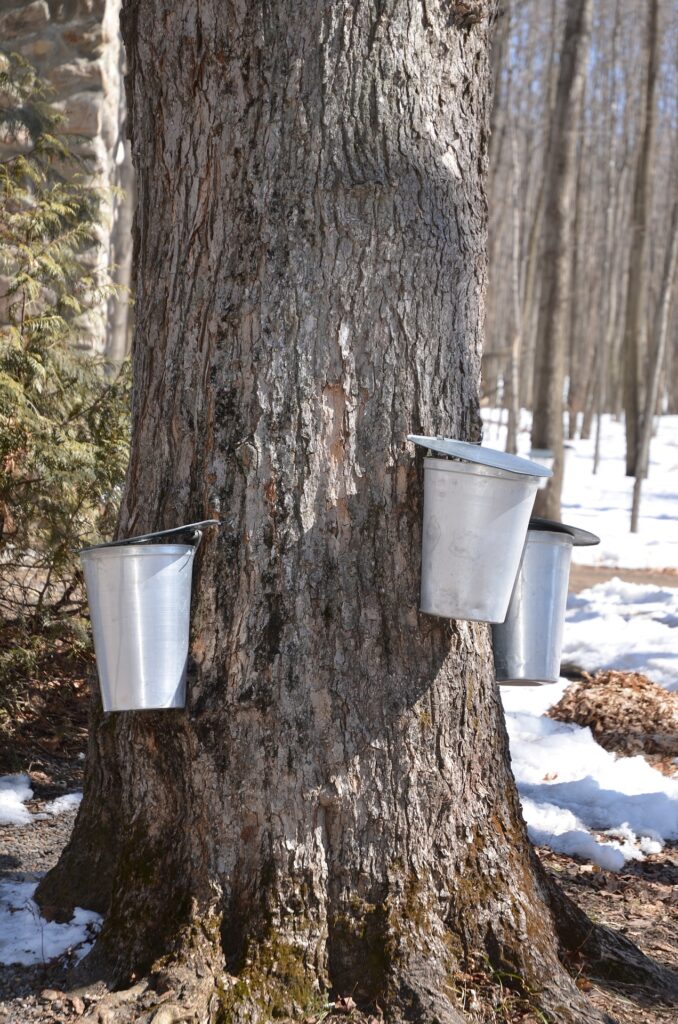
There are almost 200 farms producing more than 17,000 gallons of syrup a year in Connecticut, according to the USDA’s latest data. Connecticut ranks 10th among all maple producing states, and sugaring is generally not a full-time profession here. Many CT Grown farmers produce maple syrup to make the best use of their land and to supplement their income during the winter.
Connecticut maple syrup can be readily found at farmers’ markets, retail stores, and other local venues, including some grocery stores. Many of Connecticut’s sugarhouses are open to the public during the late winter, inviting people to learn more about how maple sap is converted to syrup and to purchase the maple products available for sale.
The maple syrup production process is accessible enough for hobbyists to try it on their own. The Maple Syrup Producers Association of Connecticut includes not only farms and sugarhouses, but also individuals and community organizations. With the purchase of some affordable equipment, anyone can tap maple trees on their property and try their hand at the sugaring process.
Choosing the right maple syrup color
Maple syrup used to come in separate grades, but this system was changed in 2015 to keep consumers from mistakenly believing that Grade A syrup was of higher quality than the darker B and C grades. While all syrup is now listed as Grade A, it still comes in four distinct colors: Golden, Amber, Dark, and Very Dark.
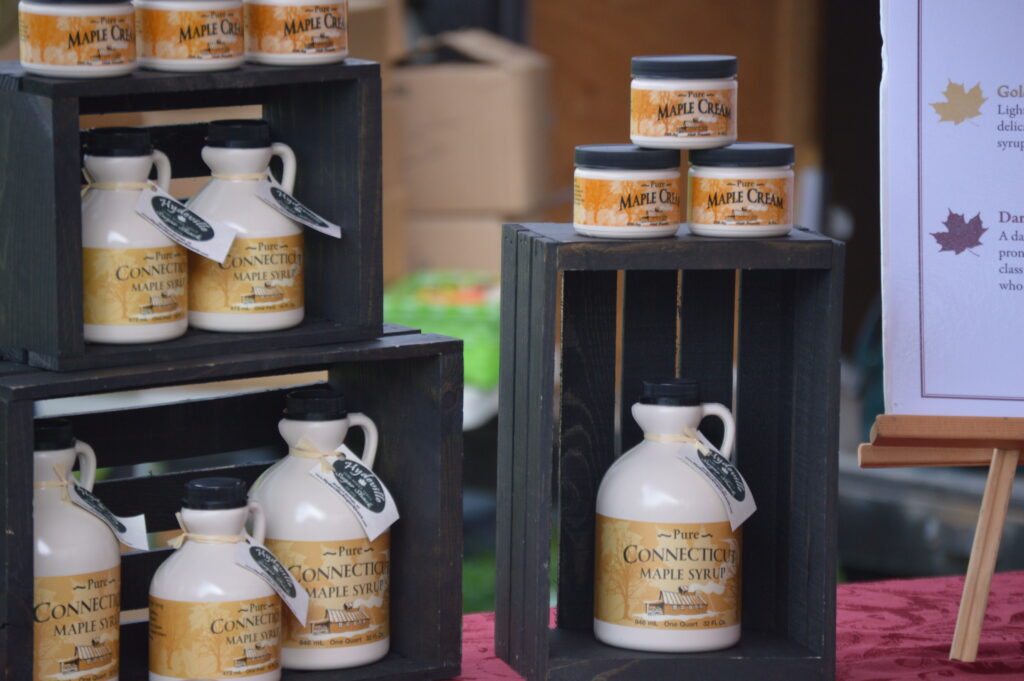
Lighter syrups come from earlier in the sugaring season and have a milder flavor. This makes them ideal for pairing with traditional breakfast foods like pancakes and waffles, pouring on ice cream, or adding flavor to beverages like coffee or cocktails.
Darker syrups indicate that the sap was collected later in the season and has a more robust and intense flavor. These varieties are best used for cooking, baking, or creating glazes.
More than just syrup
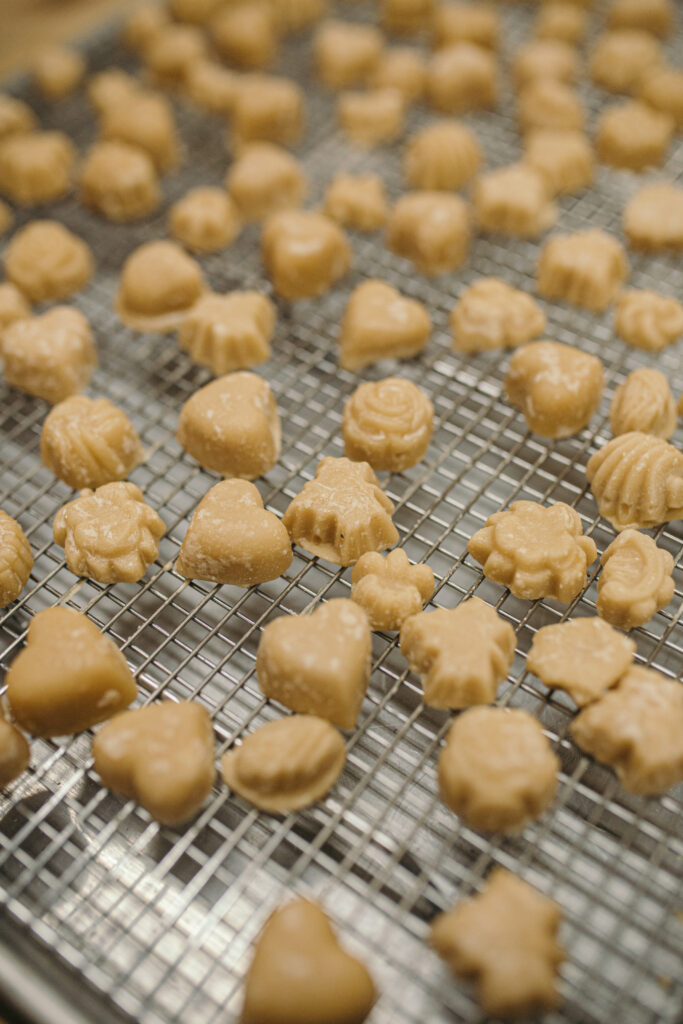
Maple syrup is the primary product created from maple sap, but there are numerous other items maple producers put out each harvest season. Some of the most popular are granulated maple sugar, maple cream, and maple candy, a simple mixture of syrup and butter which is then molded into a variety of shapes.
Maple producers also frequently partner with other farmers in Connecticut to create tasty and unique CT Grown foods. These include maple-flavored milk, yogurt, and jams and jellies.
When is sugaring season in Connecticut?
Sugaring season traditionally takes place from early February through late March. This time of year tends to include a mixture of warmer days and freezing nights, and this freeze-thaw cycle is just what is needed to get the sap flowing in maple trees.
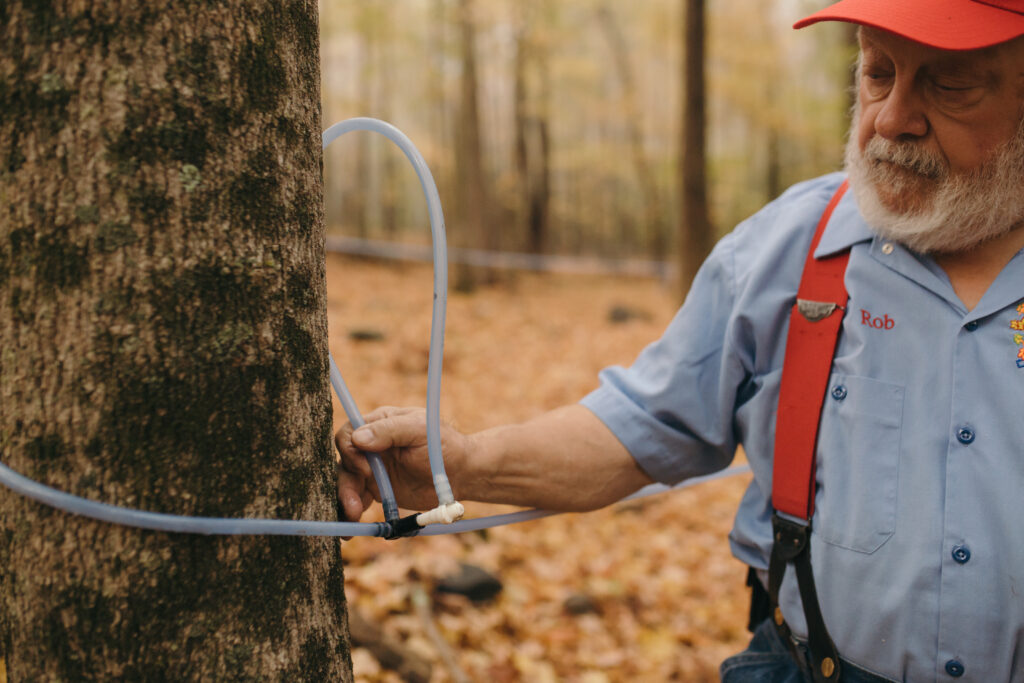
Producers make advance preparations for the sugaring season, such as deciding which maple trees to tap and collecting firewood for the sugarhouse, but the season itself only lasts about six to eight weeks. Trees are tapped using metal spouts called spiles, which allow sap to flow into covered metal buckets or through tubing to a holding tank.
After sap is collected, it is boiled to evaporate the water and increase the sugar content. The syrup is then filtered, graded, and bottled.
It’s the perfect time to pick up CT Grown maple syrup, so check out what’s at your local store or farmers’ market and mark your calendar for Maple Weekend!
Winter is the best time to start planning the next season for your garden, but time is quickly running out! Whether you’re starting a new home garden or reviving an existing one, these steps will help ensure a productive spring.
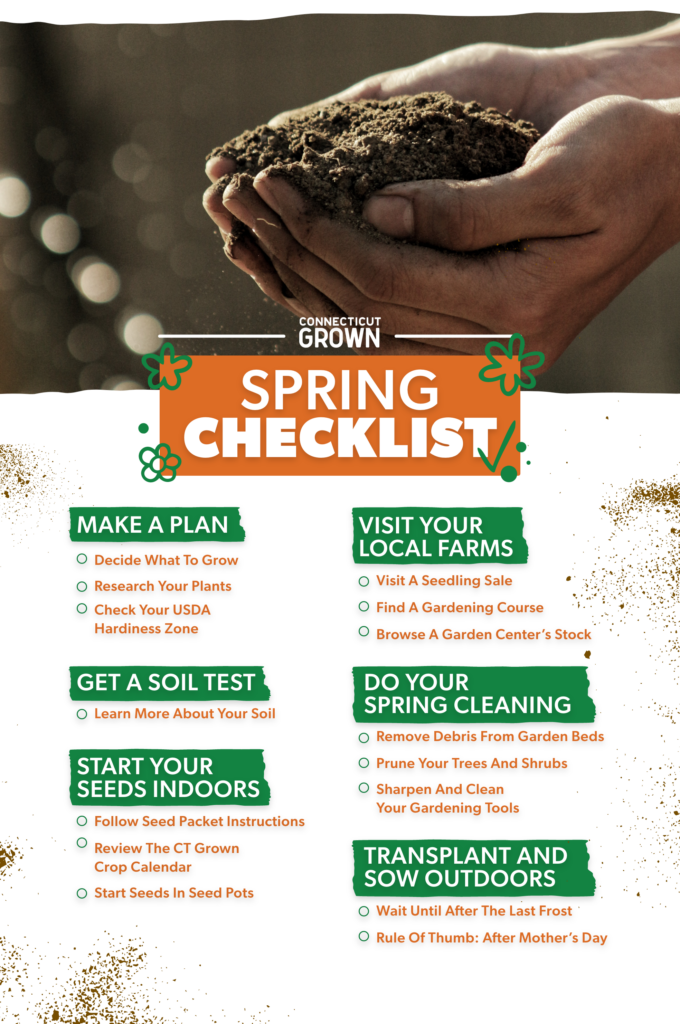
Helpful Resources
- Find your USDA Hardiness Zone
- Get your soil tested at the University of Connecticut’s Soil Nutrient Analysis Laboratory
- Check the CT Grown crop calendar
- Follow the Connecticut Nursery & Landscape Association
As part of Black History Month, we’re highlighting how Connecticut’s Black-owned farms are planting the seeds for the state’s agricultural future. In addition to providing CT Grown products for the market, Black farmers are often actively involved in nonprofit groups working to improve access to fresh food in Connecticut’s cities through urban farms, community gardens, educational programs, and more.
Agriculture remains a predominantly White profession; just 2 percent of farmers in the United States are Black. The ratio is similarly lopsided in Connecticut. The last USDA Census of Agriculture in 2017 found just 25 Black farmers responded among Connecticut’s more than 9,500 agricultural producers.
Yet many young Black farmers are actively working to change perceptions about farming and encourage people of color to consider it as a career. Let’s take a closer look at some of these producers, how they’re shaping the future of CT Grown, and how you can support them.
Echo Farm

In a profile for the Boston Globe, Robert Chang recalls how he would visit his grandparents’ small farm while growing up in Jamaica. But he didn’t give agriculture a try until he was in his 30s, when he started a backyard garden at his home in Middletown. This proved so bountiful that he set up a roadside stand to sell the surplus.
That surplus inspired Chang to start a larger farm, and in 2015 he purchased a 14-acre property in Woodstock. He now runs Echo Farm, which grows organic produce and cut flowers that he sells to restaurants, at a farm stand, and at farmers’ markets.
Chang balances farming with a full-time career in IT. He co-founded the Southern New England Farmers of Color Collaborative and has been active in other local farming organizations, including CT NOFA and the New Connecticut Farmer Alliance.
Hodges Family Farm
In 2015, Army veteran Anthony Hodges purchased an 1899 farmhouse on the outskirts of Waterbury. His original goal was to renovate the property as a way of dealing with his PTSD. Family members pitched in on the project, and then members of the community started helping to maintain the land every weekend.
Today, Hodges Family Farm is open to the public. Visitors are able to pick their own fruits and vegetables, purchase produce at a farmstand, or make day reservations to simply relax at the farm.
Micro2Life
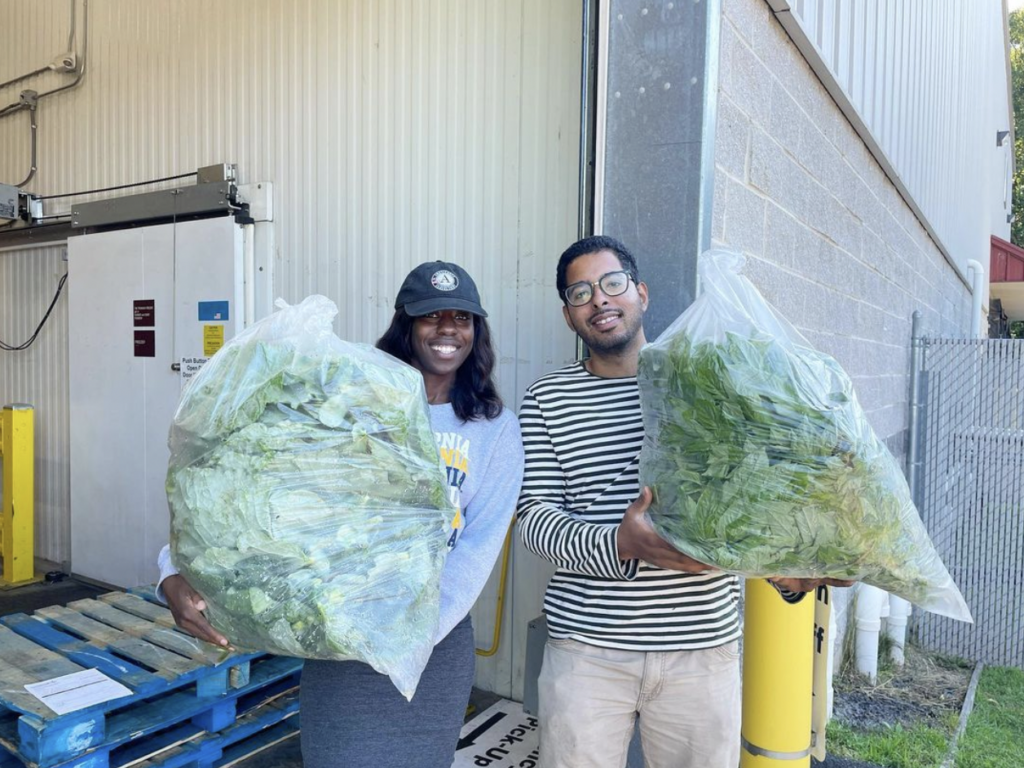
Emmanuel Marte raised his first crop while he was working in Maryland and successfully grew a tomato plant at his apartment. He began experimenting with other crops, such as growing microgreens indoors, and learned more about agriculture through KNOX Hartford after returning to Connecticut.
In 2018, Marte established Micro2Life with Zania Johnson, whom he met while studying biology and nutritional science at the University of Connecticut. Micro2Life grows organic vegetables including hydroponically produced leafy greens, peppers, turnips, and some specialty crops such as Jamaican pumpkins.
The vegetables are sold to customers as well as schools and restaurants, and some are donated to food security programs. In 2022, Micro2Life supplied CT Foodshare with over 4,000 pounds of produce.
Johnson and Marte have actively worked to encourage people to learn more about where food comes from and to consider agriculture as a career. They have given presentations in schools, conducted urban farmer training programs, and led educational courses on hydroponics and growing microgreens.
Park City Harvest

Richard Myers recalls that his classmates sometimes asked him if his name was Shawn while he was studying horticulture at Naugatuck Community College. Eventually he met “the other Black kid in the program,” Shawn Joseph, and the seed of Park City Harvest was born.
The duo founded the company in 2018, currently specialize in microgreens grown in an indoor farm, and are also adding a hoop house and honeybees. In addition, they offer value-added products such as West Indian hot sauce, pickled jalapenos, dried herbs, olive oils, teas, and T-shirts dyed by the flowers and vegetables they grow.
Aware of the small share of Black farmers in agriculture, Park City Harvest operates under the slogan “Changing the Image of Farming.” The business aims to be a supplier of fresh, sustainable, culturally appropriate food in the Bridgeport area.
Myers and Harris say there is sometimes a negative stigma in the Black community that equates farming to slave work, but that they are working to portray agriculture as a means of financial freedom. Their outreach includes a new nonprofit, North Carver Foundation, to “educate, fund, and promote all farmers of color.” They also plan to publish a cookbook and a farming-themed children’s book.
“Having the opportunity to grow food for yourselves and your community and income is empowering,” they say.
Root Life
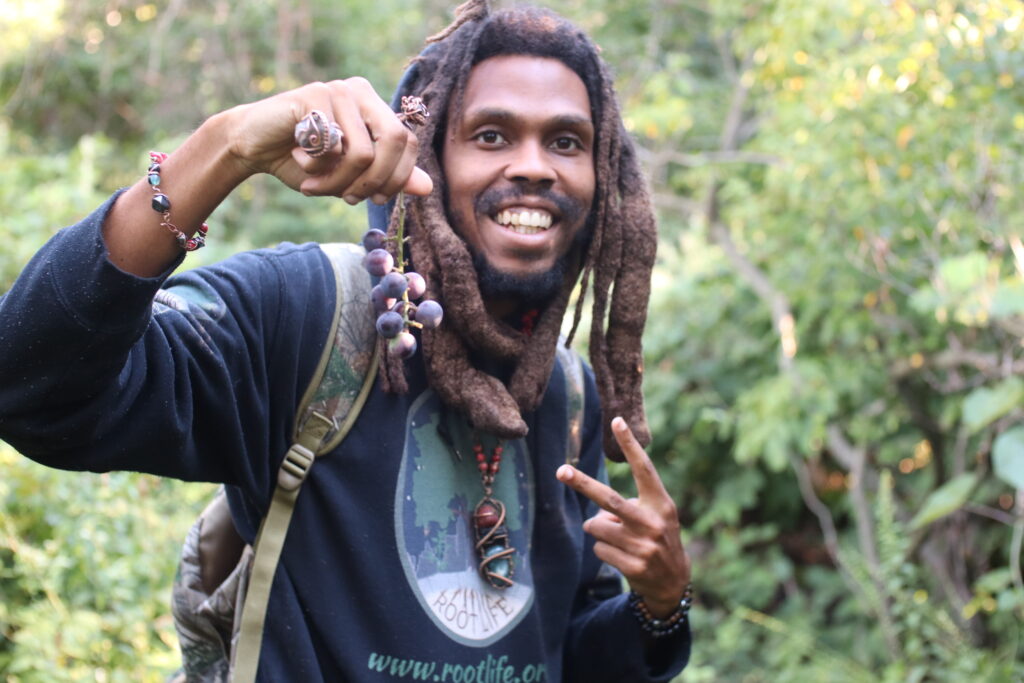
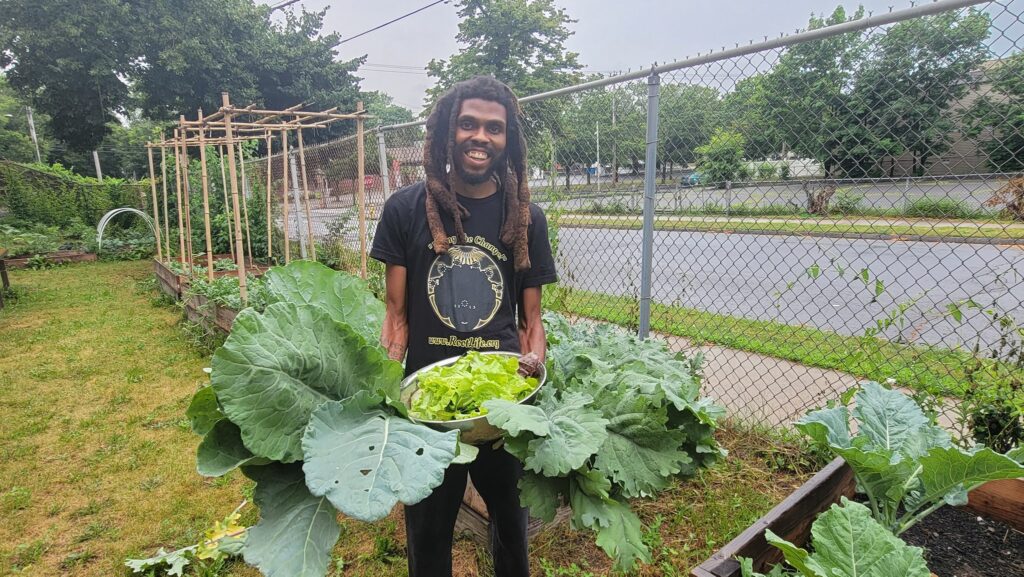
Dishuan Harris’s interest in farming began with a simple realization: while his ancestors had been able to work the land and provide for their families, he only knew how to buy his food.
Harris, a New Haven native, began volunteering with as many local agricultural organizations as he could. He was later hired as a farmer and educator with Common Ground High School in New Haven, then started his own business in 2016 with the goal of sharing the agricultural knowledge he had developed over his career.
Through Root Life, Harris (also known as Native Praxis, or Farmer D) raises organic produce such as berries, herbs, and microgreens. He farms on a selection of different community spaces, totaling about one-sixth of an acre in total.
“These grow spaces are unique because they are in the center of urban neighborhoods that currently deal with food apartheid (food deserts),” says Harris. “As a result, these grow spaces contribute more than just the production of organic produce; these spaces offer a place for the community to connect to each other and reconnect to natural spaces.”
Harris also sells vegan health and beauty products; and provides environmental consulting services on topics like edible landscaping, gardening, and farming. He plans to start selling value-added products made from locally grown and locally produced ingredients.
Harris continues to volunteer with numerous Connecticut urban agriculture groups, helping them in areas such as youth education and the startup and maintenance of community gardens. He has also established other organizations with the goal of promoting sustainability and food sovereignty, including Love Fed and Root Life Media.
Samad Gardens Initiative
Azeem Zakir Kareem remembers that it was a “culture shock” when he started working at Holcomb Farm in West Granby and saw the rows of vegetables. He says urban “food deserts” have led to a significant lack of awareness in Black populations about how their food is sourced.
Kareem had been invited to work at the farm by his wife Sarah Rose Kareem, then Holcomb Farm’s wholesale manager. In 2020, they started their own business, Samad Gardens Initiative, with the goal of inspiring and educating people of color to grow food for themselves and their communities.
Their Windsor Locks farm raises organic produce and medicinal herbs, which are sold at farmers’ markets and donated to organizations such as Connecticut Foodshare. Samad Garden Initiative also creates value-added products such as tea blends, and the Kareems offer numerous educational offerings on topics such as regenerative growing techniques and seed saving.
SEAmarron Farmstead
Liz Guerra and Hector “Freedom” Gerardo were dabbling in agriculture even when living in a Manhattan apartment, composting their food scraps on the fire escape. Shortly after they moved to Connecticut, the couple developed even more of an appreciation for locally sourced food due to the grocery shortages brought on by the COVID-19 pandemic.
As a way of promoting food sovereignty, Guerra and Gerardo established SEAmarron Farmstead on a 3.1-acre plot behind their Danbury home. They tend to a small but diverse farm operation that raises crops including vegetables, apples, and hemp. A small apiary is also on the site.
Both co-founders of SEAmarron Farmstead are involved with the New Connecticut Farmer Alliance. Gerardo has also founded the nonprofit companies E&G Community Builders and 1Freedom for All, both of which encourage people of color to address food insecurity in their communities.
To learn more about the Connecticut Department of Agriculture’s working groups to support diversity, equity, and inclusion in Connecticut agriculture, click here.
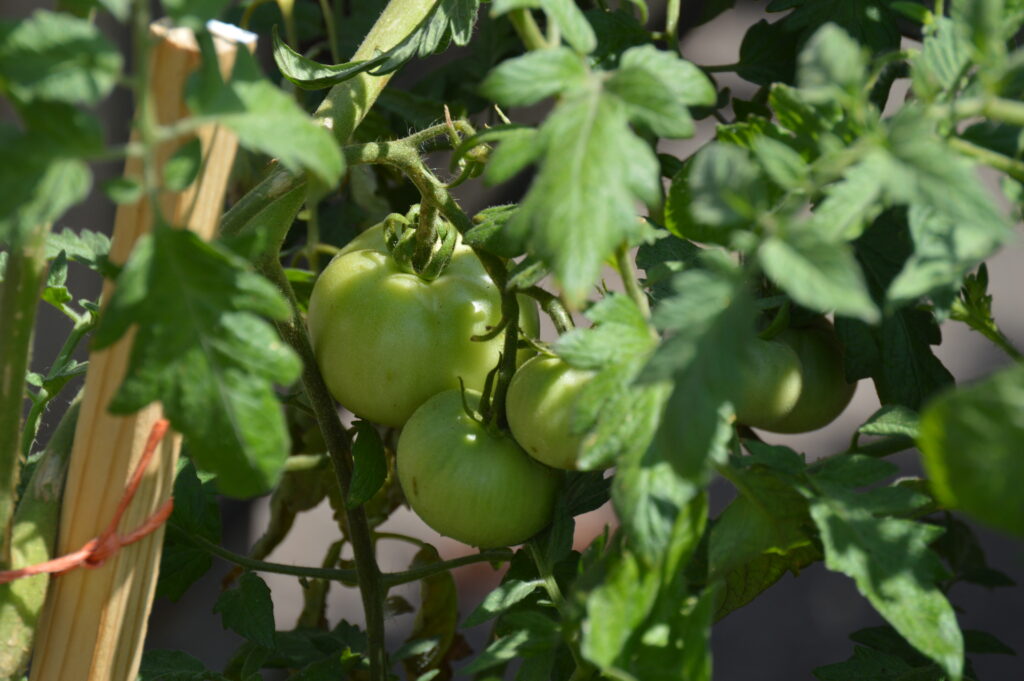

Don’t assume that a farm is closed to customers just because it’s winter. If the CT Grown farm near you has greenhouses on the property, they’ll likely still have their products available at their farm store, or at a winter farmers’ market or grocery store.
Greenhouses play a major role in sustaining CT Grown products throughout the year, representing one-third of the state’s agricultural activity. At last count, Connecticut had 12.7 million square feet of commercial greenhouse space!
Read on to learn about what CT Grown products are available year-round thanks to greenhouses. You can also read our previous articles on hydroponic farms and mushroom farms.
Winter bouquets
Flower cultivation is one of the strongest agricultural sectors in Connecticut, and greenhouses allow these farmers to offer beautiful, fresh bouquets any time of the year. And since greenhouse conditions can be adjusted to create warmer growing conditions, it’s also possible to produce ornamental flowers that wouldn’t be able to grow in Connecticut’s typical outdoor climate.
Look for the CT Grown label on floriculture products like:
- Cut flowers
- Potted plants
- Indoor foliage
- Bedding or garden plants
Protected fruits and vegetables
While the majority of greenhouses in Connecticut support the state’s vibrant floriculture industry, there are also more than 150 farms that grow fruits and vegetables under glass or other protection. This enables CT Grown farmers and producers to continue providing a steady supply of food to stores and winter farmers’ markets throughout the year.
Greenhouses are large enough to support fruiting trees and other crops that need more vertical space. Farmers have also used other protective methods—such as hoop houses, row covers, and high tunnels—to warm the soil, shelter crops from the wind and cold, and extend their growing seasons.
Crops that can be found earlier in the year, or even throughout the year, due to greenhouses and other protective structures include:
- Arugula
- Beets
- Broccoli
- Cucumbers
- Eggplant
- Greens
- Herbs
- Kale
- Lettuce
- Radishes
- Salad greens
- Scallions
- Spinach
- Tomatoes
Explore Connecticut’s greenhouses
There are nearly 600 commercial greenhouses located throughout Connecticut. To find one near you, visit the CT Grown map.
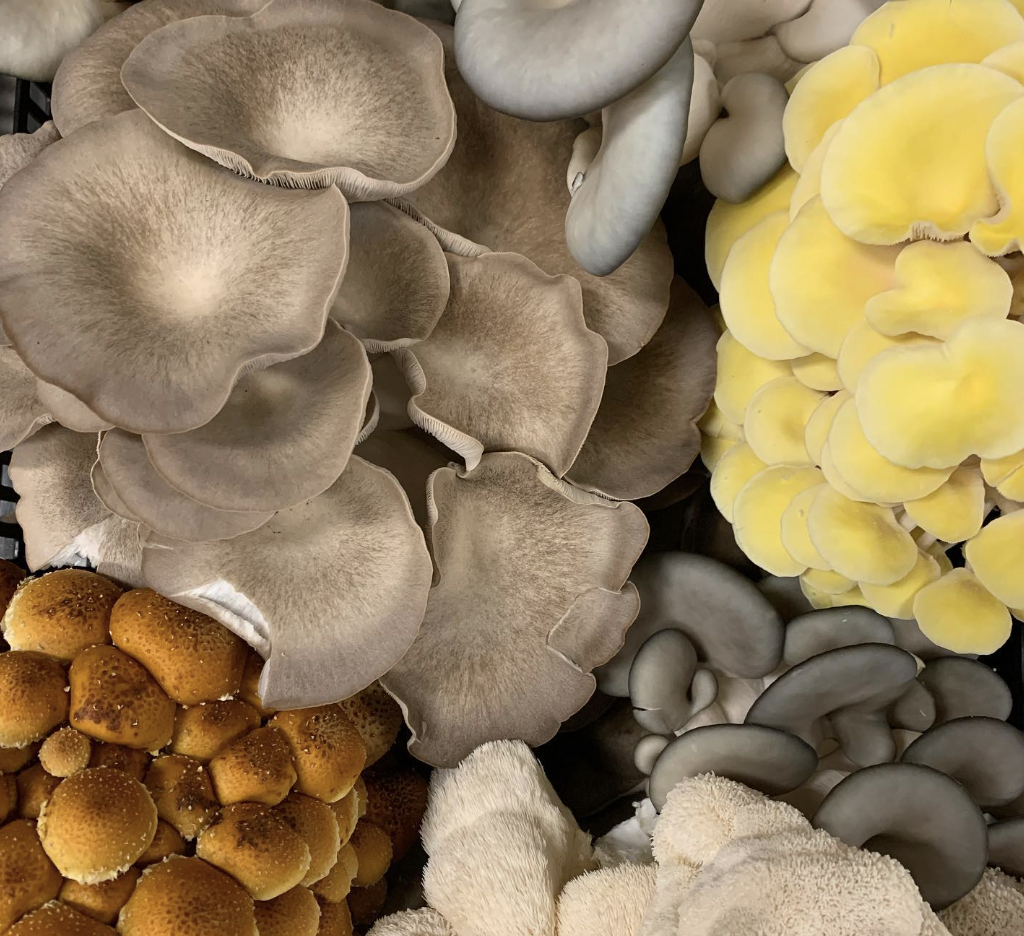
Whether you use them in a stir fry, on a pizza, or with a meat entree, mushrooms are a terrific way to add extra flavor and nutrients to a dish. And you don’t have to go far to find them — mushrooms are a CT Grown crop whose harvest season never ends!
Mushrooms thrive in indoor growing environments, allowing farmers—and consumers—to constantly be collecting them. Read on to find out where you can find CT Grown mushrooms and how you can add them to your dinner plan.
Popular CT Grown mushroom varieties
Indoor farming allows for the production of numerous varieties of mushrooms. Here’s a look at some of the most popular options, and how you can prepare them.
Lion’s mane: A favorite in gourmet cooking, lion’s mane mushroom has a tender texture and juicy flavor that is often compared to seafood. Naturally, this makes it a good choice to accompany dishes like lobster, crab, and scallops — or to serve as a non-meat alternative to these choices in vegetable dishes.
Maitake: Offers a rich taste described as earthy and peppery. It pairs well with vegetable dishes, and is also a good choice for savory entrees like steak.
Morel: With a nutty, earthy flavor, morel mushrooms are a great side dish on their own. They also do an excellent job strengthening the flavors in pasta dishes.
Oysters: A common mushroom with a mild flavor, oyster mushrooms are an easy way to add more nutrients to a meal. There are several different varieties of this mushroom, such as blue oyster and golden oyster, offering subtle differences in flavor.
Shiitake: One of the most popular types of mushroom, shiitake is intensely flavorful with an earthy, buttery taste. It works well as its own dish, on pizza, or with meat or fish.
Explore Connecticut’s mushroom farms

Mushrooms are a fast-growing industry in Connecticut, with USDA statistics showing the number of mushroom farms in the state tripling between 2012 and 2017. Some CT Grown mushroom farms include:
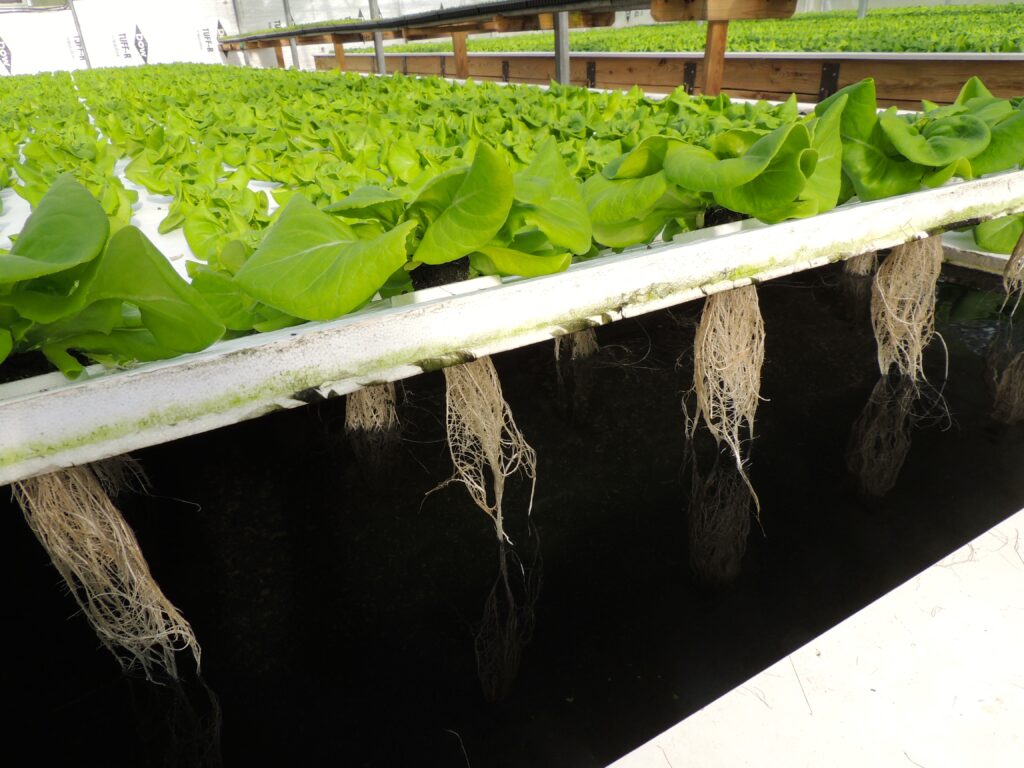
Are you in the mood for fresh, local produce but don’t think you’ll be able to get it until Connecticut’s fields and gardens come out of hibernation? Think again! With farmers increasingly taking advantage of indoor farming, you can find CT Grown fruits and vegetables throughout the winter.
In this series of articles, we explore the different ways Connecticut farmers are continuing to supply their farm stores, winter farmers’ markets, and grocery stores with fresh produce. Today, we’ll see how innovative methods like hydroponic farms are extending the harvests of several fruits and vegetables.
Which crops grow well indoors?
Indoor farming allows the growing seasons for certain items to last the whole year, or nearly so. The CT Grown crop calendar says these vegetables include:
- Arugula
- Beets
- Greens, including beet greens, collards, mustard greens, salad greens, and turnip greens
- Kale
- Lettuce
- Radishes
- Spinach
Indoor farming methods have also been successful in producing crops like celery, cucumbers, eggplant, herbs, peppers, squash, strawberries, tomatoes, and zucchini.
How can plants grow indoors?
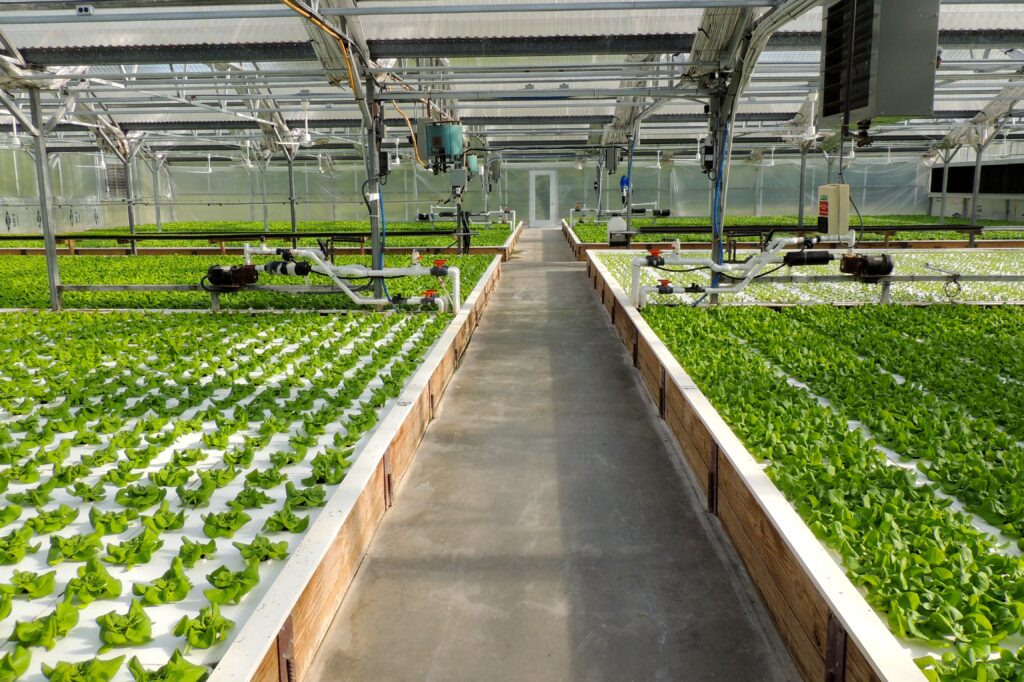
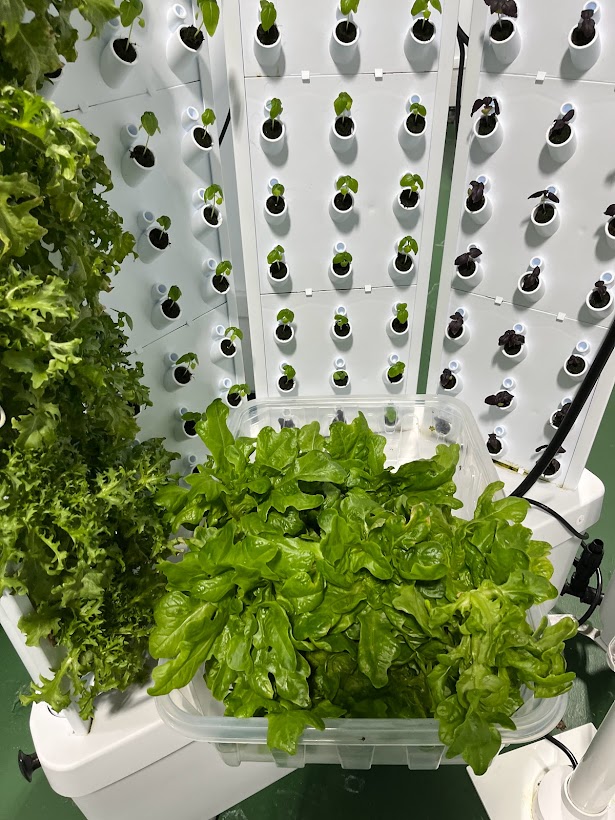
Indoor farms rely on artificial lighting along with careful monitoring and control of water, nutrients, and other plant needs. Vertical farming practices are used to stack layers of crops on top of one another, maximizing the use of the space available in a structure.
Unlike traditional farming, indoor farming can be done without the use of soil. Hydroponic systems use a water-based nutrient medium instead of soil to grow crops, while aeroponic systems simply have a plant’s root systems dangle in the air. Aquaponic systems pair a hydroponic operation with an aquaculture farm, using its water to raise fish or other aquatic species.
Since indoor farms can be located in a wide variety of structures, they can be located closer to population centers — reducing the time it takes to bring products to market.
Explore Connecticut’s hydroponic farms

Hydroponic farms in Connecticut include:
CT Food 4 Thought – Patricia H. Mayfield Hydroponics Center
“I don’t think I need a box of vegetables every week.”
It’s a leading concern we hear from people who aren’t sure if they’ll benefit from joining a CSA (Community Supported Agriculture) program. They worry that their CSA will have more vegetables than they can use each week (or that it won’t have the kind of produce they’ll use), resulting in wilted vegetables and lost money.
Rest assured, CSAs aren’t just limited to boxes of vegetables; there are options available for a wide variety of products, including meat, flowers, and seafood. Just like traditional CSAs, they allow CT residents to enjoy fresh food, get to know their local farmers and producers, and enjoy member perks while supporting Connecticut’s agricultural economy.
CT Grown farmers have also improved the flexibility of their CSAs in key, innovative ways. Read on to find out about the different types of CSAs that can fit your lifestyle.
Meat CSAs
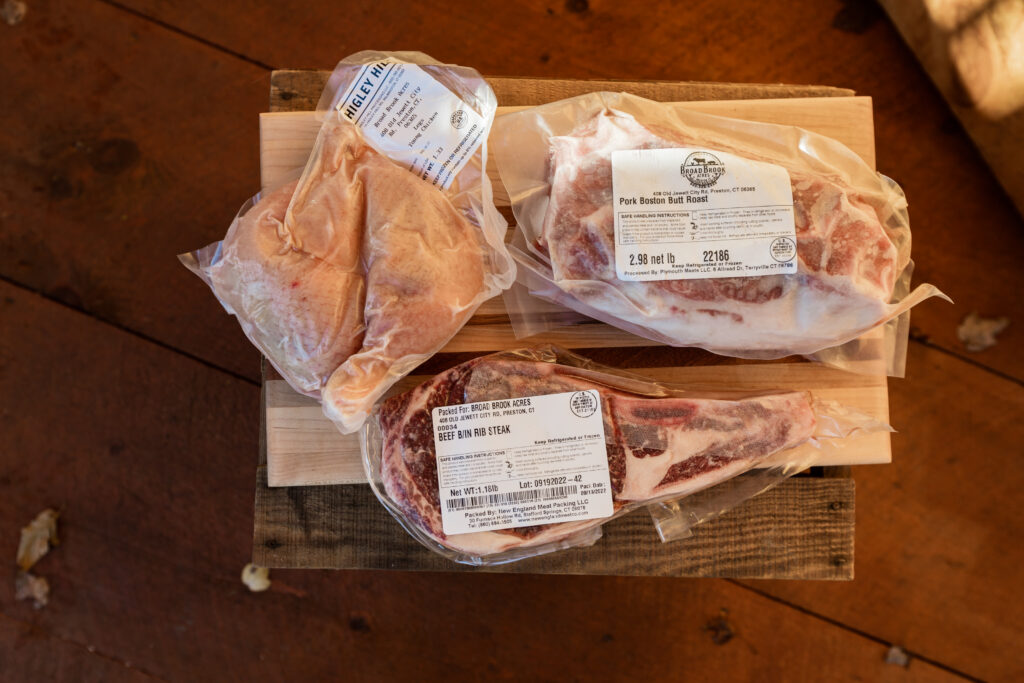
Across Connecticut, livestock farmers are raising thousands of animals from the traditional beef, poultry, and pork to a bit more exotic such as bison and emu.
While traditional CSAs provide different types of vegetables, meat CSAs offer a variety of meat cuts such as chops, sausages, ribs, roasts and ground meat. The program may provide a few pounds of meat every week, or monthly pickups with a larger selection.
CT Grown livestock producers are open to sharing the sustainable practices they use to raise their animals. Some practices include grass-fed diets, pasture-raised practices which are said to yield a higher nutritional value and better taste.
Meat CSAs can work particularly well for those who are worried that their CSA shares will be inconsistent or that they will let food go to waste. Since meat CSAs are based on weight, you’ll be guaranteed a set amount of food with each share. Any meat you don’t use can be stored in the freezer until you need it.
Community Supported Fisheries (CSF)
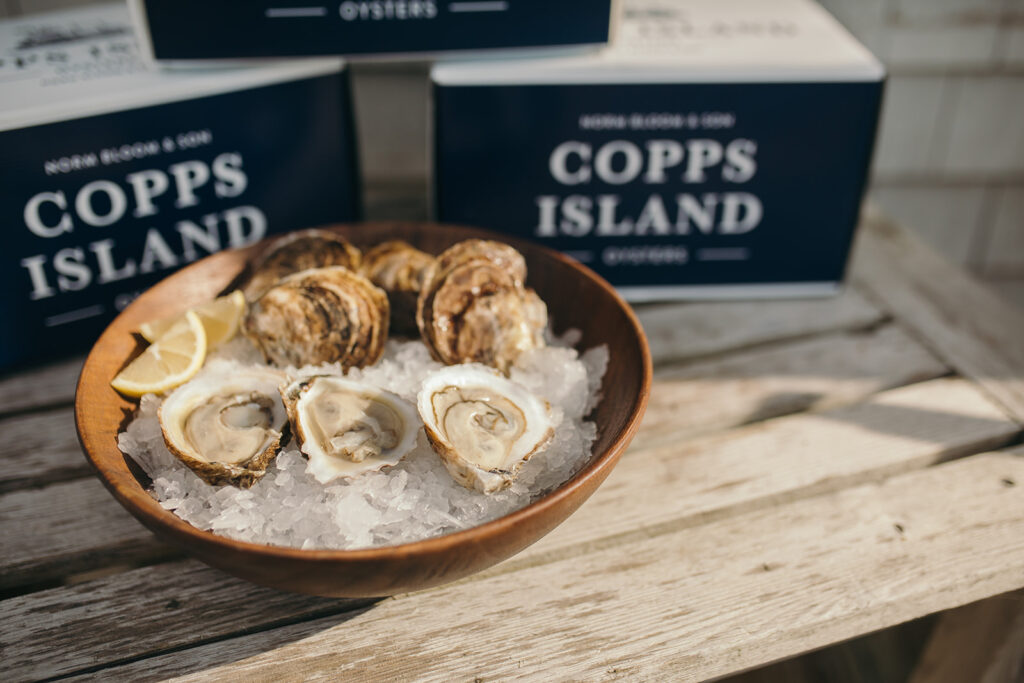
Similar to meat CSAs, Community Supported Fisheries (CSF) programs let you enjoy fresh seafood soon after it has landed on Connecticut’s shores. In exchange for your upfront payment, you’ll get regular shares of aquaculture products like fish, shellfish, and kelp.
CSF programs work to make these products available to the consumer as quickly as possible. Seafood is purchased from local fishermen, then processed and made available for pickup.
While traditional CSAs help farmers cover the costs of each new growing season, CSFs help CT Grown aquaculture producers to pay for expenses like boat repairs and the purchase of new gear.
Flowers and seeds
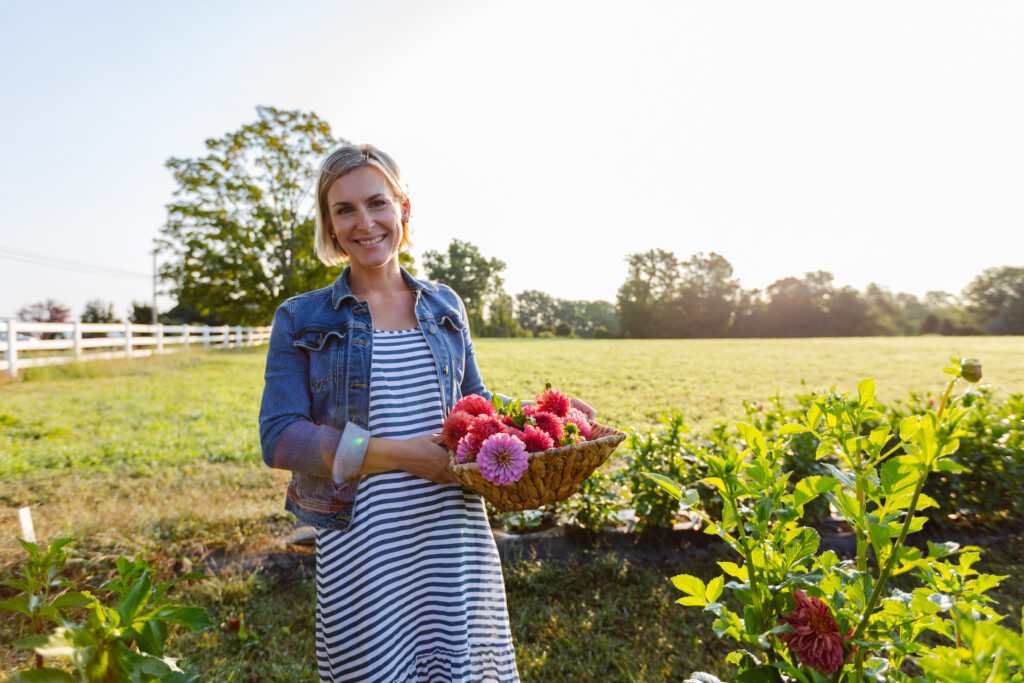
Countless families have picked up locally produced flowers to add beauty and fragrance to their home. If you want to keep these displays as a more consistent part of your home decor, you might consider a flower CSA.
Flower CSAs offer bouquets of flowers with an ever-changing variety based on what’s in season. You may have the option of picking your own flowers, and some CSAs even provide seed packets so you can grow additional lovely blooms in your own garden.
This type of CSA gives you the freshest flowers possible, since you’ll be getting them directly from the farm. It can also be a good option for those looking to try out a CSA for the first time, as flower CSAs tend to be less expensive and cover a shorter span of time.
Subscriptions and customizable shares
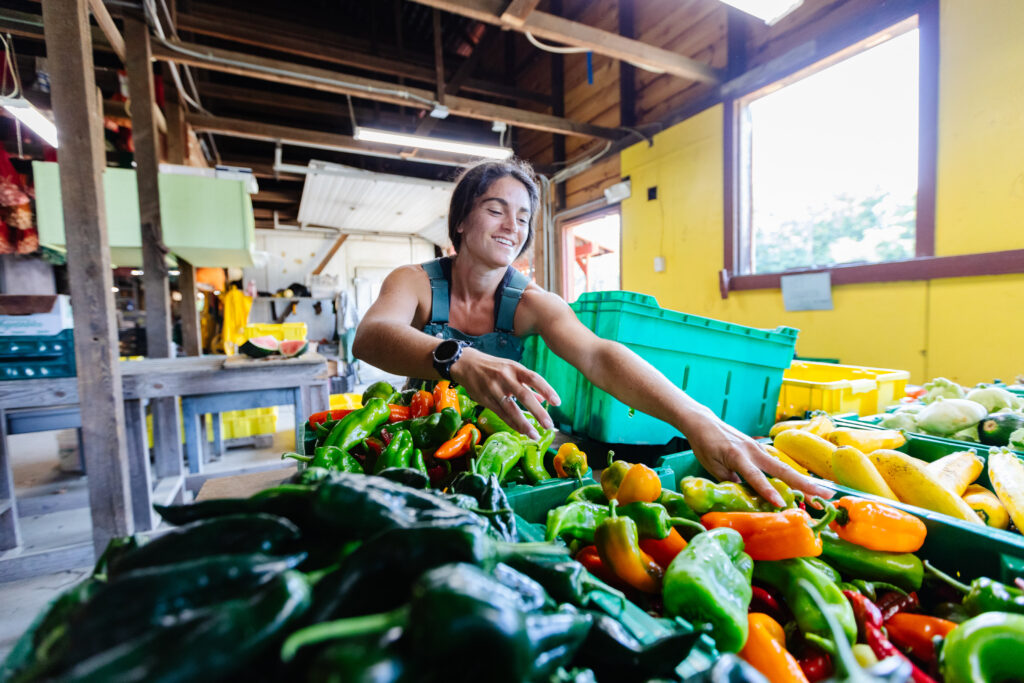
Farms can offer programs that are similar to CSAs but provide more opportunities for flexibility and customization. Vegetable subscription boxes let you choose how frequently you receive your produce and how many weeks your subscription will run. CSAs also may have a “market style” setup, allowing you to pick and choose what you’d like to take home.
Programs may involve collaborations between multiple producers in order to provide a range of goods. Some Connecticut dairy farms have started subscription delivery services that not only bring milk to your doorstep, but also goods like eggs, granola, and breads.
If you frequently use a certain commodity, you may find a farm offering a CSA exclusively for this item. These specialty CSAs include items like bread, cheese, eggs, honey, maple syrup, milk, and mushrooms.
CSAs sometimes invite you to pick your own produce as part of the experience. Instead of getting a preselected portion of fruits or vegetables, you might be invited to head into the fields to take your pick of items like berries, flowers, herbs, hot peppers, snap peas, or tomatoes.
To learn more about how CSAs work, visit our previous blog. To find a CSA near you, visit this map.
Everything You Need to Know About Connecticut CSAs
Farmers may be less visible during the winter months, but that doesn’t mean they aren’t hard at work. Some, like dairy and livestock farmers, continue to bring products to stores and markets year-round. Those that rely primarily on crop sales spend the winter buying seeds, upgrading equipment, and otherwise preparing for the growing season.
One innovative way to support CT Grown farmers during the winter is to purchase a share in a Community Supported Agriculture (CSA) program. Many farms in Connecticut begin opening these programs for signups at the start of the year.
CSAs are beneficial to both farmers and consumers. By purchasing a share of the upcoming harvest in advance, you can help sustain a farm’s cash flow and ensure that it is well-prepared for the season ahead. You’ll also enjoy a better understanding of how your food is grown, a closer connection with your local farms, and consistent access to fresh produce, proteins and flowers.
Each farm has its own unique way of offering a CSA. This guide will help you to understand the program and how it can help you to support local farmers and eat healthier foods.
How does a CSA work?
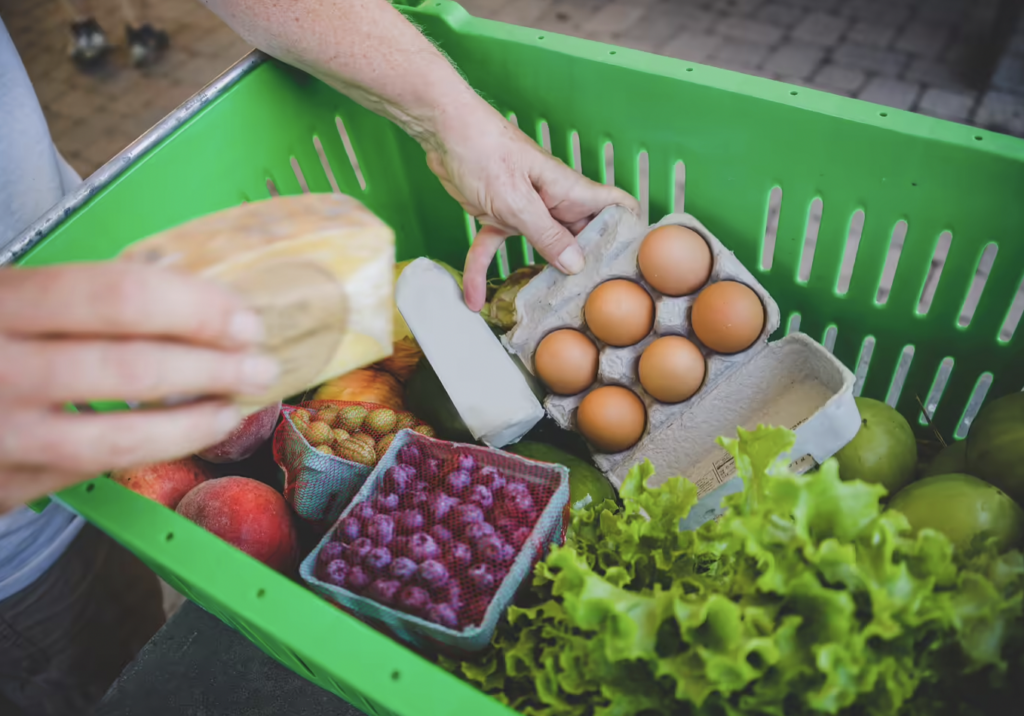
CSAs follow a simple shareholder model. By paying in advance during the winter, you purchase a share of the farm’s crop during the upcoming season. You receive your share on a weekly or biweekly basis, over the course of several weeks or the full growing season.
Only a limited number of shares are available, with the idea that this will create a closer relationship between farms and shareholders. By communicating with shareholders about their preferences, farmers can also be better prepared for the growing season ahead.
Why should I sign up for a CSA?
There are numerous benefits to signing up for a CSA. These include:
- A regular supply of fresh CT Grown fruits, vegetables, and other products
- Produce that retains more of the nutrients present at harvest, since it spends less time in transit or storage
- Getting introduced to new foods which you may not have otherwise tried
- Knowing exactly where your food comes from
- Supporting a local business, including farms committed to sustainable and environmentally conscious operations
- Regular visits to your local farm or farmers’ market — a particularly enjoyable outing for families with young children!
- Useful supplements like recipes and tips on how to prepare the latest share
- Members-only perks like farm stand discounts or free surplus shares during bountiful harvests
What do I get in a CSA share?
The food in your CSA share will depend on what the farm produces, so you should check ahead to see if they’ll provide the fruits, vegetables, and other items you enjoy. Items will also vary with the season; for example, CSAs offering vegetables tend to proceed from greens and early root vegetables in the spring to a wider array of produce in the summer and hardy root vegetables in the autumn.
CSAs aren’t just limited to fruits and vegetables; some keep you supplied with meat or cut flowers. Farms may also provide bonus products or optional add-on shares for locally produced goods like eggs, cheese, honey, dairy products, or mushrooms.

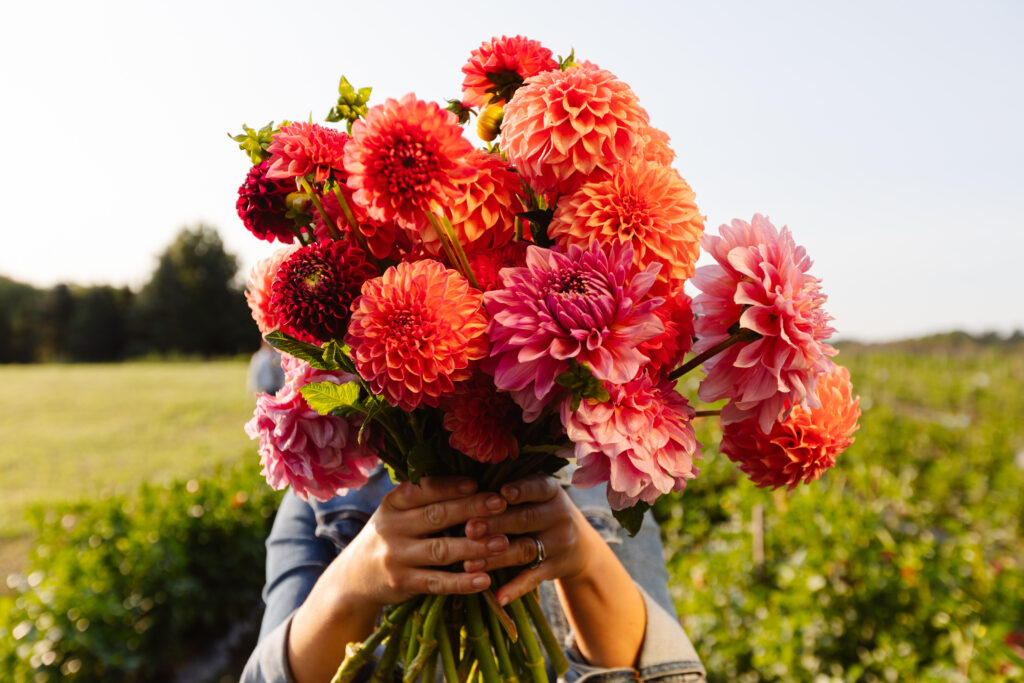
CSA shares feature items produced on the participating farm, but sometimes bring in food from partnering farms and producers to offer a wider variety.
While CSA shares are typically prepackaged, some offer a “market style” pickup option. In this arrangement, you visit the farm and choose from a selection of available produce and goods.
How large are the shares?
CSAs offer several share sizes. In addition to a full share, you’ll find options to purchase a half share or a quarter share.
Farmers advise that you consider factors like your household size and eating habits when picking your share size. A large share is usually recommended for a family of at least four, while half shares are more suitable for couples.
When do I get my CSA shares?
The typical CSA season runs from June through October. However, some farms offer optional extensions in the spring and winter. Spring CSAs feature greens and early crops, while winter CSAs include winter vegetables, food grown using indoor farming techniques, and value-added foods like relishes, sauces, and jams.
Farms set specific times and days of the week for CSA members to pick up their shares.
Where do I pick up my CSA shares?
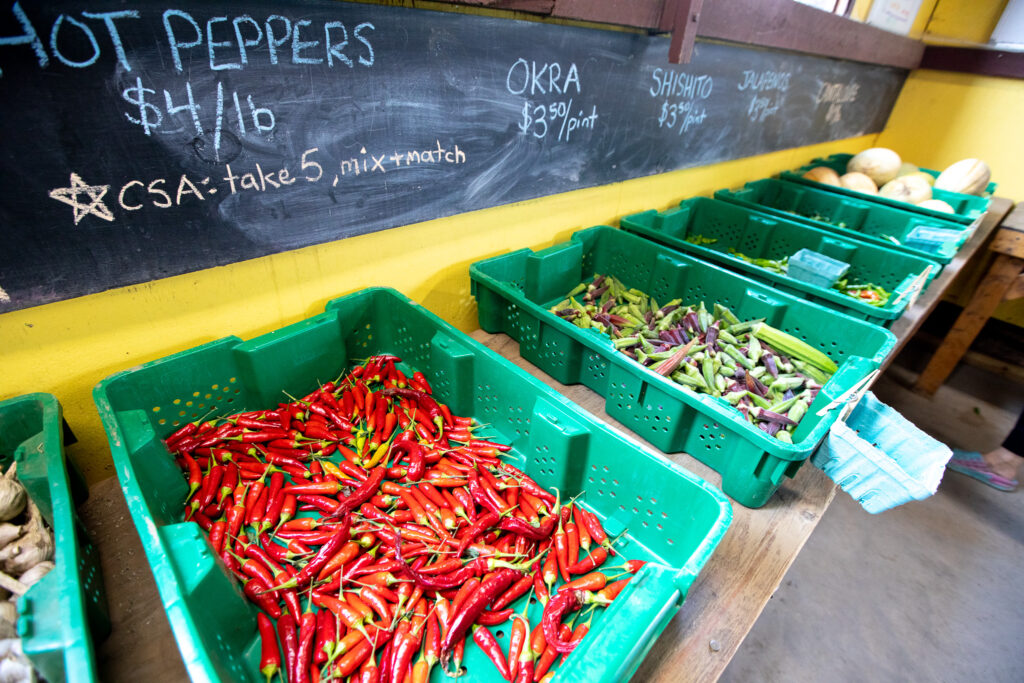
CSA pickups take place on the farm itself, but farms frequently set multiple pickup locations for better convenience. For example, CSA members may be able to collect their share at a farmers’ market where the farm sets up each week.
Some programs offer to deliver CSA shares directly to homes within a certain distance of the farm. However, this service usually comes with an extra fee.
What happens if I miss a pickup?
Farmers sometimes offer to hold on to your share to pick up at your convenience if you are unable to make one of the scheduled pickup dates. However, some warn that this option is not available due to busy schedules or concerns about the perishability of the share.
If you are on vacation or otherwise know you’ll miss a scheduled date, you can arrange to have someone else pick up the share instead. Alternatively, farmers may arrange to give you a double share at your next pickup.
If no arrangements are made, unclaimed shares are usually donated to a local charitable organization.
Is a CSA cost-effective?
Yes! A CSA’s upfront cost typically translates to about $25 to $50 per week during the harvest season. CSAs are designed to, at a minimum, offset the produce purchases you would otherwise be making in the store.
However, members often find that they’ve received goods worth more than their initial payment by the end of the season. Farms use strategies such as basing their CSA costs on wholesale prices, discounting shares for early signups, giving CSA members regular discounts in their farm stores, and providing surplus shares during strong seasons to ensure that members get a good return on their investment.
How do I pay for a CSA?
Each farm has its own payment methods, but many accept cash, checks, and credit cards. A processing fee may be charged for credit card payments.
While traditional CSAs require the cost to be paid in full in advance, some programs have payment plans to spread the purchase over the season through regular weekly or monthly contributions.
In addition, some farms provide unique options such as scholarships, workshares, or even bartering to offset or cover the cost of a CSA share.
Can I use SNAP/EBT to purchase a CSA?
SNAP/EBT can be used to purchase a CSA, as long as certain requirements are met. The benefit can be processed through a SNAP-eligible farm or vendor, or through a SNAP-eligible farmers’ market. Only SNAP-eligible items can be included in shares given to those using this payment method.
Furthermore, SNAP/EBT rules require that prepaid items must be received within 14 days. SNAP/EBT also cannot be used to pay for items bought on credit, or to pay for certain costs associated with operating a CSA, including taxes, down payments, and administrative, delivery, or membership fees.
While these rules prohibit the use of SNAP/EBT funds to make an upfront payment, they do require that farms follow certain steps to abide by these rules. People using SNAP/EBT may need to sign a written agreement committing them to the CSA. These agreements are meant to establish a clear understanding that a portion of the recipient’s SNAP/EBT benefits will go toward the CSA, and that the recipient is responsible for picking up their share. Participating farms may also require an upfront deposit using non-SNAP funds.
Some farms have established their own programs to provide CSA shares to low-income families in their communities. These programs may use donations from the community to cover the cost of a share, or offer shares at reduced rates to qualifying families.
What are the risks of signing up for a CSA?
Farmers acknowledge that there are certain risks to signing up for a CSA. Shareholders get a portion of the farm’s harvest, and shares will not be as robust if the farm is affected by drought, disease, or other factors leading to a diminished crop.
However, farms take several steps to minimize this risk. These include providing a limited number of shares, giving CSA members first priority in receiving produce, planting a surplus crop, and supplementing undersized shares with items from partnering farms.
Shareholders must also be prepared to regularly pick up and use their shares in order to get the best value from their purchase. Since a CSA purchase commits a shareholder to the full season, refunds are typically not available if you decide partway through the season that you no longer want to participate.
How do CSAs support CT Grown farmers?
The key benefit CSAs provide to farmers is cash flow during the winter months, when they are typically relying on revenues from the previous year’s growing season. The money provided through CSA purchases helps cover costs like seed and equipment purchases as well as the spring’s startup labor costs.
By communicating with their members about their preferences, farmers can anticipate the market demand in the upcoming season. This, in turn, can guide their decisions on what to grow and how much to plant.
CSAs also help to both minimize and distribute the risks associated with agriculture. By allowing a stronger cash flow during the winter, they help farmers start the growing season strong. And by having many people invest in a year’s crop, CSAs also ensure that a less productive year is not financially crippling for the farmer.